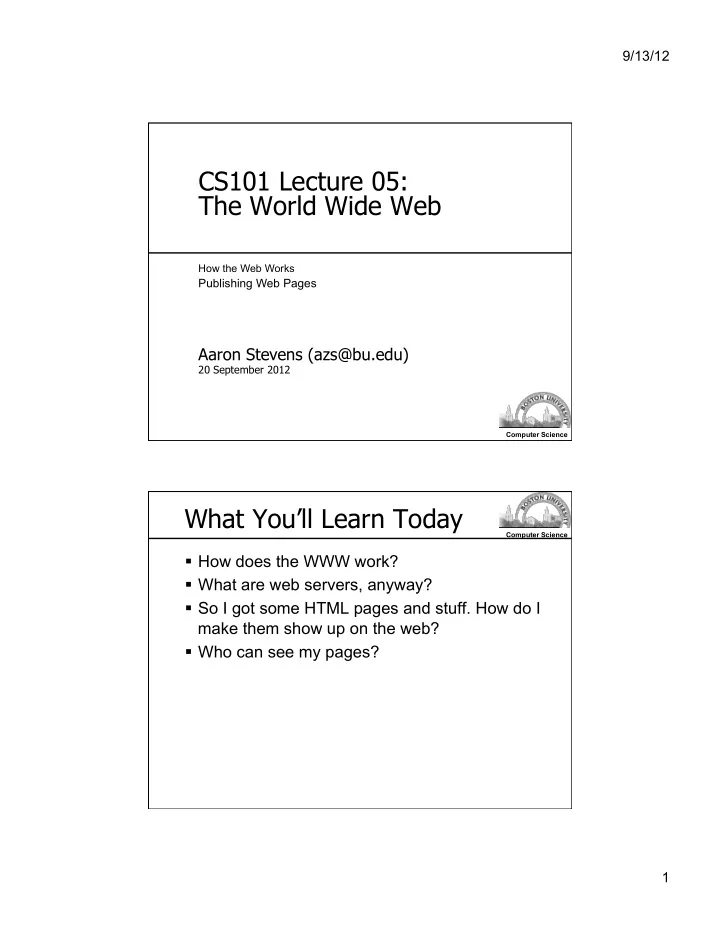

9/13/12 CS101 Lecture 05: The World Wide Web How the Web Works Publishing Web Pages Aaron Stevens (azs@bu.edu) 20 September 2012 Computer Science What You’ll Learn Today Computer Science How does the WWW work? What are web servers, anyway? So I got some HTML pages and stuff. How do I make them show up on the web? Who can see my pages? 1
9/13/12 The World Wide Web Computer Science The World Wide Web A system of interlinked hypertext documents and other resources accessed via the Internet. Tim Berners-Lee invented the WWW circa 1989-1991. http://www.w3.org/People/Berners-Lee/ The World Wide Web Computer Science How do we find stuff on the web? Uniform Resource Locator A standard way of specifying the location of a resource, it ’ s name, and how to get it. 2
9/13/12 Protocols Computer Science A protocol is a set of rules governing the exchange or transmission of data between devices. How do you visit a website? Computer Science You don ’ t visit a website. The website gets delivered to you. 3
9/13/12 HTTP Computer Science HyperText Transfer Protocol http://www.ltg.ed.ac.uk/ ~ht/WhatAreURIs/ The Web Server? Computer Science Web server: a software application which waits for/responds to HTTP requests. Tim Berners-Lee wrote 2 applications to make the web: A web browser called WorldWideWeb A server called HTTPd The first WWW Server at CERN. 4
9/13/12 Web Servers Computer Science Contemporary web servers use high- performance hardware: (fast network and disk access) Pictured: IBM Blade Servers hosting files.myopera.com, photo from Wikipedia How a Web Server Works Computer Science Receives HTTP Request Search for resource (file) on disk Send HTTP Response (status code + data) If not found: status 404 (NOT FOUND) If not permitted: status 403 (FORBIDDEN) … Else: status 200 (OK) + send data Speaking of HTTP status codes, check out: https://grepular.com/Abusing_HTTP_Status_Codes_to_Expose_Private_Information 5
9/13/12 How to Publish a Web Page Computer Science 1. Create HTML document, locate ancillary files (e.g images). 2. Transfer files to web server 3. Set permissions for read access 4. Test the URL in your browser cs-people.bu.edu Computer Science Our WWW server is cs-people.bu.edu . Main page is http://cs-people.bu.edu/ Subdirectories for individual users: http://cs-people.bu.edu/<username> Example: http://cs-people.bu.edu/azs 6
9/13/12 Your UNIX Home Directory Computer Science Each user has a UNIX “ home ” directory: General form: /cs/course/<section>/<username>/ Example: /cs/course/cs101a2/azs/ This has a UNIX pseudonym of ~. Also mapped to your Windows Z:/ drive. Your WWW Directory Computer Science The web server will map your URL: http://cs-people.bu.edu/<username>/ to your UNIX ’ s account ~/public_html/ directory (or Z:/public_html/ on Windows). 7
9/13/12 Locate files in Finder/Windows Explorer Computer Science Find your files on your local computer How to Transfer Files to csa2.bu.edu Computer Science Use a file transfer client-program: Fetch (Mac) http://fetchsoftworks.com/ (a free academic license is available) WinSCP (Windows) http://winscp.net/eng/index.php (also free) 8
9/13/12 Connecting by WinSCP: Computer Science Hostname: csa2.bu.edu Be sure to use the “ SFTP ” protocol WinSCP to csa2.bu.edu Computer Science WWW Local Server Computer After you connect, transfer files by drag ’ n ’ drop. Then right-click to set permissions. 9
9/13/12 File Protection Computer Science Users and Groups Many operating systems (for example, Unix) have a concept of users (each with unique username/password). Users are organized into groups. Example: I ’ m in all of these groups: faculty3 cs108grades cs101stuff cs108stuff cs101grades Example: you are in one of these group: cs101a2, cs101a3, cs101a4, cs101a5, cs101b2, cs101b3 or cs101b4 File Permissions Computer Science Each file has its own set of permissions for: Reading, writing or executing Owner, group, or others This leads to a 3x3 matrix of permissions: 10
9/13/12 Setting Permissions by WinSCP Computer Science Right-click to open this dialog Set the permissions to 644 Transferring File by Fetch Computer Science Use drag ’ n ’ drop interface to transfer files… WWW Server Then use the Get Info button to set permissions. 11
9/13/12 Setting Permissions by Fetch Computer Science Set permissions to 644 Testing the Webpage: Computer Science After uploading the files, test in your browser: 12
9/13/12 index.html Computer Science There are two special filenames that the web server looks for automatically: home.html � index.html Create the file index.html as the “ main landing ” page for your website, which corresponds to the URL: http://cs-people.bu.edu/<username>/ � Example: What You Learned Today Computer Science HTTP revisted, Web server UNIX home directory File Transfer Protocol UNIX File Permissions index.html 13
9/13/12 Announcements & To Do List Computer Science Readings: HTML Tutorial http://www.w3schools.com/HTML/ Reed ch 3, pp. 53-57 (today) http://www.webpagesthatsuck.com HW 3 due 9/25 Computer Science 14
Recommend
More recommend